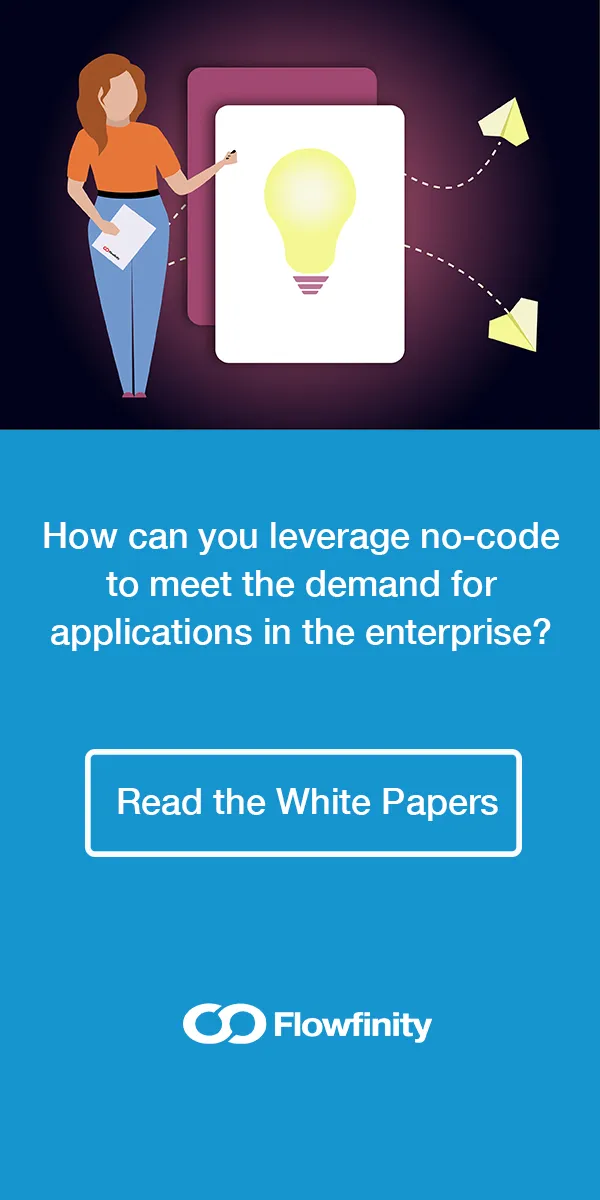The missing piece of the puzzle: Big picture thinking for workflow process systems
Mar 22, 2019
By Alex Puttonen

Avoid relying on excessive integrations for business process management systems success.
Background
Effective business process management often involves determining when a legacy system has reached the end of its useful life and considering replacement options. Unfortunately, organizations commonly take too narrow a view when gathering requirements for new systems and end up pigeonholing a new 'piece' into an existing puzzle of processes and integrations.
As the rate of change continues to accelerate this tunnel vision can lead to system upgrades that seem like a quick fix becoming needlessly time-consuming and complex. Additionally, analysts and managers run the risk of missing opportunities for truly meaningful digital transformation by cobbling together components in a piecemeal fashion with superficial results.
By stepping back and framing your entire workflow from end-to-end you can more easily identify processes and sub-processes that could be streamlined or combined to create a simpler and more reliable long-term solution.
Why does Flowfinity recommend this approach?
When you view your workflow in aggregate instead of as individual system components you can gain insights that allow you to change the whole picture of your systems puzzle instead of being left wondering why key pieces seem to be missing or don't fit.
Before deploying any new technology in to your ecosystem it is important to ensure that you have the right foundation, new applications deployed alongside legacy systems can expose cracks in your application stack that could become business problems or even security concerns. It may be better to lay a brand-new foundation and rebuild your database and processes from the ground up rather than continuing to plaster over cracks in integrations as they spread and widen.
It is common for businesses to underestimate the power of relational database driven tools when implementing mobile data collection applications.
In a typical case a client wanted to improve a process where sales reps in the field submitted a spreadsheet for authorization to provide competitive discounts. This was hurting the business units bottom line as the turnaround time for the spreadsheet could be several days. By this time prospects had already made purchasing decisions, often with competing firms able to price match more quickly at the point-of-sale.
The requirements defined were for a solution that would allow users to submit the information electronically to speed up the process, and then generate a copy of the spreadsheet for central office as this was the existing result of their current state workflow.
Flowfinity helped by providing tools to create a solution that allowed reps to submit requests directly on mobile devices, with a live 2-way database connection that was instantly available and editable both in the field and central office. This was not just a superficial improvement to their process; it completely updated the workflow. No more need for the spreadsheet!
How do I take a big picture look?
Consider the key components of organizational health: people, processes and technology. State-of-the-art technology will not deliver value without the proper processes in place for people to follow in support of it.
There are effectively three ways to approach implementing a successful new mobile business process workflow system:
1. Replace your entire process with an end-to-end system that removes all need for external integrations.
When possible the best solution is often to bring all of your processes under one system. Although the current trend is towards easier integration, and many IT departments will celebrate this a good thing, the reality is that API's break, integrations become compromised when updates occur and in general the less connectivity you rely on the better.
If you can identify one system that can handle your existing data and take care of collection and storage in a flexible format that meets present and future needs, it is worth considering a full migration away from disparate systems that may have difficulty working together as you grow.
At the core of this system should be relational database model with the ability to evolve with your business. Worthwhile modern systems accept a wide variety of data types and provide intuitive tools to create and edit your workflow applications without code.
2. Break your process down into logical sub-processes with systems dedicated to each sub-process and integrated.
Larger and more sophisticated firms will often have complex processes that live within an Enterprise Resource Planning system (e.g. SAP or Microsoft Dynamics) that may be too inflexible to effectively handle specific use-cases. If custom sub-processes are required then ensure the external application you adopt has the ability to integrate reliably with your ERP.
In this situation integration is warranted however the ideal solution will minimize touchpoints to ensure duplicate data is avoided and integrations remain optimized as upgrades and process changes occur.
Using our solution, a workflow process starts and lives independently in Flowfinity until it is finished, the results are then committed to the ERP for long term storage and access. This way the scope of integrations is limited and well defined for greater reliability.
3. Keep your process and existing systems intact, however increase efficiency by digitizing your data collection with mobile data collection.
In some cases, the underlying processes and systems are sound. In others the existing infrastructure is highly complex and the benefit from a complete redeployment doesn't justify the effort. In either scenario underlying systems are better left alone rather than reengineered.
Efficiencies for firms of all sizes can still be found by improving the collection and visibility of data fed into the system. An effective approach for many organizations is to streamline the data entry process by taking advantage of mobile form technology.
When you put 2-way real time access to your system data in the hands of your field staff you gain improved operational efficiency and informational accuracy. By adopting a mobile data collection app tied to your existing system you can greatly reduce the time spent on record management without reinventing the wheel when it comes to your core technology.
What is Flowfinity?
Flowfinity software is a unique relational database driven workflow solution that provides the tools you need to easily create your own mobile applications without code. Our team can help you assess your current situation and determine a vision for the future state of your digital transformation.
Conclusion
Don't be puzzled by all of the potential integrations when planning updates to your business process management systems. If you step back and examine your entire workflow you may find opportunities to merge processes that are currently performed in disparate systems in to one unified workflow that requires less effort to maintain going forward.
Flowfinity can collect, store and display all of your data in real-time on a central database accessible from the office or on mobile devices. We'll help you leverage the power of digitization with simple declarative tools to configure complex workflow processes. Our technology provides greater reliability than managing a patchwork of systems while retaining the flexibility needed to integrate with leading ERP systems for a truly big picture solution.

